Prospectors have been searching for gold in creeks and rivers for centuries. Panning for gold can be a real thrill, but it’s not always easy.
In this article, we’ll cover some tips and tricks for successfully finding gold in a creek or river.
1. Understand the geology of the area:
Before you start panning for gold, you should at least have a basic understanding of the geology of the area you’ll be exploring. Gold is often found in areas where there has been volcanic activity or where there are sedimentary rocks. Knowing some of the basics can help lead you to gold.
Geological features like quartz veins or exposed bedrock can be very helpful. These can be good indicators that gold may be present in the area.
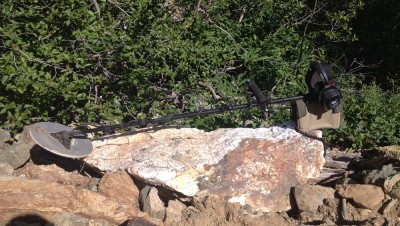
This large chunk of bull quartz was discarded from a large mining operation in Western Oregon. While this piece did not contain any gold, I have found many smaller pieces in this area that had small gold veins running through the quartz. In this mining area, quartz is an excellent indicator for possible gold nearby.
Even if you don’t know much about geology, there are a few simple things to keep an eye out for. Looking for signs of past mining activity is one of the best indicators there is. An understanding of the regional history can have a big impact, helping you find the best area to start digging.
2. Use the right equipment:
To be successful at finding gold in a creek or river, you’ll need the right equipment. A gold pan is essential, as is a small shovel and a basic classifier to sift out larger rocks and debris. This is what you will use to sample different areas quickly.
With a gold pan, you can sample many different areas quickly. Only once you have located some gold in your pan will you want to set up larger equipment.
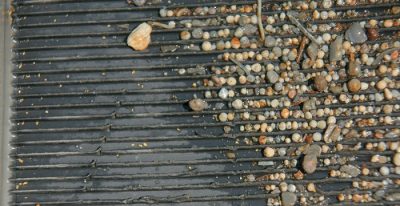
Gold pans are a “must have” item for any prospector. They allow you to sample lots of different areas quickly. Only after you have found a deposit of gold should you consider setting up a sluice box or other piece of large equipment. Make sure you are on top of the gold before you set up a larger operation.
Assuming you have some luck and you know your area is gold-bearing, you may also want to invest in a sluice box or a highbanker, which can help you process larger amounts of material more quickly. With motorized equipment, you’ll want to check applicable laws and regulations for your area.
A metal detector can also be useful for finding nuggets or other larger pieces of gold. The most important thing about metal detecting for gold nuggets is the presence of gold that is large enough that your detector can “hear” it. Even a good quality metal detector will go right over fine gold dust without making a sound.
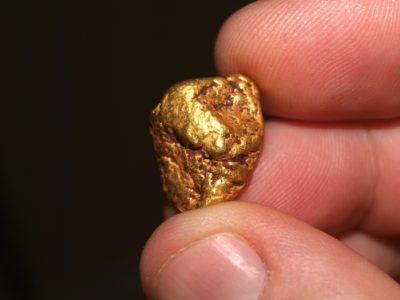
Everyone wants to find a big gold nugget like this! Unfortunately they are very, very, VERY rare. A metal detector can be an excellent tool for finding them, but you have to make sure you are in an area that has them in the first place. Much less than 1% of the creeks and rivers on Earth contain large gold nuggets.
3. Look for the right conditions:
To increase your chances of finding gold, it’s important to look for the right conditions. Gold doesn’t distribute itself equally throughout a river or a creek. It is often found in areas where the water flow slows down.
Look for areas where the water is moving slowly or where there are natural obstructions that can trap gold particles.
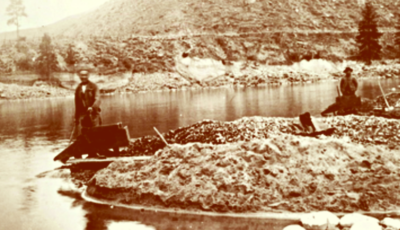
This old picture from the 1800s shows two miners that have set up a rocker box on the inside bend of a major gold-bearing river in Idaho. The gold in this area is generally very fine, but the inside bend creates slowing water that causes gold to drop into the gravel and settle into paystreaks.
You may also want to focus on areas where the water has carved out a deeper channel, as these areas can contain concentrated areas where gold will get naturally trapped.
Bedrock is also very important and worth seeking out. Gold will drop down to bedrock and get stuck in small cracks. Use small tools to dig out the material from these cracks and pan it out. This can be very rewarding!
4. Practice proper technique:
You can have all the right equipment, but without some basic technique you are probably going to struggle. Gold panning is a skill that takes practice to master.
Start by filling your gold pan with material from the creek or river. Use your classifier to sift out larger rocks and debris, then swirl the pan gently in the water to wash away the lighter material. As you work through the material in your pan, continue to swirl it gently and remove any remaining rocks or debris.
With practice, you’ll learn to recognize the telltale glint of gold in your pan.
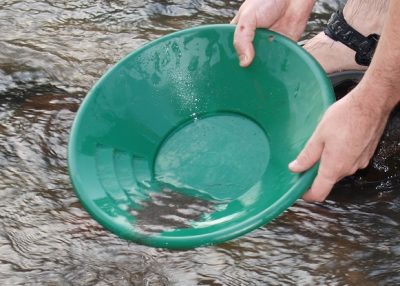
Learning a proper panning technique takes some time. A modern plastic pan with built-in riffles can help keep you from accidentally losing gold.
5. Be patient!
So many people give up before they’ve really even started. Gold prospecting is not easy, and you will come up empty-handed more often than not. Don’t expect to find gold in every pan.
In my opinion, the single biggest “short cut” to successfully finding gold is to put yourself in a KNOWN AREA where gold has been found before. You can have all the patience in the world, but if you are prospecting in an area that simply doesn’t have any gold then you aren’t going to find any.
6. Stay Out of Legal Trouble
Gold prospecting and mining is highly regulated in the United States and most other countries. It is critical that you are knowledgable on the rules and regulations for the area that you are prospecting.
Avoid disturbing sensitive habitats or damaging plants and wildlife. And always pack out any trash or debris you generate while panning for gold. Even if what you are doing is legal, consider how the impact will be perceived by other people out recreating on the water. If you are causing significant impact to the landscape or other disturbance that may cause issue, be aware of it and reconsider.
Gold prospecting is under high scrutiny these days, and we don’t need to bring troubles onto ourselves. Fisherman, rafters, swimmers and other outdoorsman use these same areas.
The Gold Prospector’s Field Guide – A Modern Miner’s Handbook
Top 10 States for Serious Gold Miners
Determining if Land is Open to Prospecting







